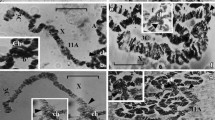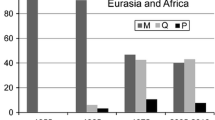Summary
We report a detailed molecular analysis of three chromosomal rearrangements, which have been produced during I-R hybrid dysgenesis in Drosophila melanogaster. They all disrupt the yellow gene. One of them is a deletion; the other two are inversions, which may be interpreted as the results of recombination events between I elements inserted at their break points. These events appear to occur at the time of transposition and involve integrating rather than resident I elements. They are produced by a mechanism very similar to homologous ectopic recombination.
Similar content being viewed by others
References
Appleyard RK (1954) Segregation of new lysogenic types during growth of a doubly lysogenic strain derived from Escherichia coli K12. Genetics 39:440–452
Arber W, Enquist L, Hohn B, Murray NE, Murray K (1983) Experimental methods for the use of lambda. In: Hendrix RN, Roberts JW, Stahl FW, Weisberg RA (eds) Lambda II. Cold Spring Harbor Laboratory Press, Cold Spring Harbor, New York, pp 501–513
Biemont C, Gautier C, Heizmann A (1988) Independent regulation of mobile element copy number in Drosophila melanogaster inbred lines. Chromosoma 96:201–294
Biggin MD, Gibson TY, Hong GF (1983) Buffer gradient gels and 35S label as an aid to rapid sequence determination. Proc Natl Acad Sci USA 80:3963–3965
Bregliano J-C, Kidwell MG (1983) Hybrid dysgenesis determinants. In: Shapiro HA (ed) Mobile genetic elements. Academic Press, New York, pp 363–404
Bucheton A, Lavige JM, Picard G, L'Heritier P (1976) Non mendelian female sterility in Drosophila melanogaster: quantitative variations in the efficiency of inducer and reactive strains. Heredity 36:305–314
Bucheton A, Paro R, Sang HM, Pelisson A, Finnegan DJ (1984) The molecular basis of I-R hybrid dysgenesis in Drosophila melanogaster: identification, cloning and properties of the I factor. Cell 38:153–163
Campuzano S, Carramolino L, Cabrera CV, Ruiz-comez M, Villares R, Boronat A, Modolell J (1985) Molecular genetics of the achaete-scute gene complex in Drosophila melanogaster. Cell 40:327–338
Chia N, Howes G, Martin M, Meng YB, Moses K, Tsubota S (1986) Molecular analysis of the yellow locus of Drosophila. EMBO J 5:3597–3605
Crozatier M, Vaury C, Busseau I, Pelisson A, Bucheton A (1988) Structure and genomic organization of I elements involved in I-R hybrid dysgenesis in Drosophila melanogaster. Nucleic Acids Res 16:9199–9213
D'Ambrosio E, Waitzkin SD, Witney FR, Salemme A, Furano AV (1986) Structure of the highly repeated, long interspersed DNA family (LINE or L1Rn) of the rat. Mol Cell Biol 6:411–424
Davis PS, Shen MW, Judd BH (1987) Asymmetrical pairings of transposons in and proximal to the white locus of Drosophila account for four classes of regularly occuring exchange products. Proc Natl Acad Sci USA 84:5843–5847
Di Nocera PP, Casari G (1987) Related polypeptides are encoded by drosophila F elements, I factors and mammalian L1 sequences. Proc Natl Sci USA 84:5843–5847
Engels WR, Preston CR (1984) Formation of chromosome rearrangements by P factors in Drosophila. Genetics 107:657–678
Fawcett DH, Lister CK, Kellett E, Finnegan DJ (1986) Transposable elements controlling I-R hybrid dysgenesis in D. melanogaster are similar to mammalian LINEs. Cell 47:1007–1015
Finnegan DJ (1988) I factors in Drosophila melanogaster and similar elements in other eucaryotes. Symp Soc Gen Microbiol 43:271–283
Finnegan DJ (1989) The I factor and I-R hybrid dysgenesis in Drosophila melanogaster. In: Berg DE, Howers NM (eds) Mobile DNA. Am Soc Microbiol, pp 501–515
Frischauf AM, Lehrach H, Poustka AM, Murray NE (1983) Lambda replacement vectors carrying polylinker sequences. J Mol Biol 170:827–842
Geyer PK, Spana C, Corces VG (1986) On the molecular mechanism of gypsy-induced mutations at the yellow locus of Drosophila melanogaster. EMBO J 5:2657–2662
Goldberg ML, Sheen JY, Gehring WJ, Green MM (1983) Unequal crossing-over associated with asymmetrical synapsis between nomadic elements in the Drosophila melanogaster genome. Proc Natl Acad Sci USA 80:5017–5021
Gough JA, Murray NE (1983) Sequence diversity among related genes for recognition of specific targets in DNA molecules. J Mol Biol 166:1–19
Green MM (1961) Complementation at the yellow locus in Drosophila melanogaster. Genetics 46:1385–1388
Hattori M, Kuhara S, Takenaka O, Sakaki Y (1986) L1 family of repetitive DNA sequences in primates may be derived from a sequence encoding a reverse transcriptase related protein. Nature 321:625–628
Karn J, Brenner S, Barnett L, Cesaerini C (1980) Novel bacteriophage cloning vector. Proc Natl Acad Sci USA 77:5172–5176
Kazazian HH Jr, Wong C, Youssoufian H, Scott AF, Phillips DG, Antonarakis SE (1988) Haemophilia A resulting from de novo insertions of L1 sequences represent a novel mechanism for mutation in man. Nature 332:164–166
Kimmel BE, Moiyoi OK, Young JR (1987) Ingi, a 5.2 kb dispersed sequence element from Trypanosoma brucei that carries half of a smaller mobile element at either end and has homology with mammalian LINEs. Mol Cell Biol 7:1461–1475
Lavige J-M (1986) I-R system of hybrid dysgenesis in Drosophila melanogaster: further data on the arrest of development of the embryos from SF females. Biol Cell 56:207–216
Lefevre G Jr (1976) A photographic representation and interpretation of the polytene chromosomes of Drosophila melanogaster salivary glands. In: Ashburner M, Novitski E (eds) The genetics and biology of Drosophila, vol 1a. Academic Press, NY, pp 31–66
Lindsley DL, Grell EH (1968) Genetic variations of Drosophila melanogaster. Carnegie Institution of Washington, publication no 627
Loeb DD, Padgett RW, Hardies SC, Shehee WR, Comer MB, Edgel MH, Hutchison III CA (1986) The sequence of a large L1Md element reveals a tandemly repeated 5′ end and several features found in retrotransposons. Mol Cell Biol 6:162–182
Maniatis T, Fritsh EF, Sambrook J (1982) Molecular cloning. A laboratory manual. Cold Spring Harbor Laboratory Press, Cold Spring Harbor, New York
Murray NE (1983) Phage lambda and molecular cloning. In: Hendrix RW, Roberts JW, Stahl FW, Weisberg RA (eds) Lambda II. Cold Spring Harbor Laboratory Press. Cold Spring Harbor, New York, pp 395–432
Norrander Y, Kempe T, Messing Y (1983) Construction of improved M13 vectors using oligodeoxy nucleotide directed mutagenesis. Gene 26:101–106
Picard G (1976) Non mendelian female sterility in Drosophila melanogaster: hereditary transmission of I factor. Genetics 83:107–123
Picard G, L'Heritier P (1971) A maternally inherited factor inducing sterility in D. melanogaster. Drosophila Inf Serv 46:54
Picard G, Bregliano J-C, Bucheton A, Lavige J-M, Pelisson A, Kidwell MG (1978) Non mendelian female sterility and hybrid dysgenesis in Drosophila melanogaster. Genet Res Camb 32:275–287
Priimagi AG, Mizrokhi LJ, Ilyin YV (1988) The Drosophila mobile element Jockey belongs to LINEs and contains coding sequences homologous to some retroviral proteins. Gene 253–262
Roeder GS (1983) Unequal crossing-over between yeast transposable elements. Mol Gen Genet 190:117–121
Sang HM, Pelisson A, Bucheton A, Finnegan DJ (1984) Molecular lesions associated with white gene mutations induced by I-R hybrid dysgenesis in Drosophila melanogaster. EMBO J 3:3079–3085
Sanger F, Nicklen S, Coulson AR (1977) DNA sequencing with chain terminating inhibitors. Proc Natl Acad Sci USA 74:5463–5467
Schwarz-Sommer Z, Leclerq L, Gobel E, Saedler H (1987) Cin-4, an insert altering the structure of the A1 gene in Zea mays, exhibits properties of non-viral retrotransposons. EMBO J 6:3873–3880
Singer MF (1982) SINEs and LINEs: highly repeated short and long interspersed sequences in mammalian genomes. Cell 28:433–434
Will BM, Bayev AA, Finnegan DJ (1981) Nucleotide sequence of terminal repeats of 412 transposable element of Drosophila melanogaster. A similarity to proviral long terminal repeats and its implications for the mechanism of transposition. J Mol Biol 153:897–915
Author information
Authors and Affiliations
Additional information
Communicated by D.J. Finnegan
Rights and permissions
About this article
Cite this article
Busseau, I., Pelisson, A. & Bucheton, A. I elements of Drosophila melanogaster generate specific chromosomal rearrangements during transposition. Molec Gen Genet 218, 222–228 (1989). https://doi.org/10.1007/BF00331272
Received:
Issue Date:
DOI: https://doi.org/10.1007/BF00331272




